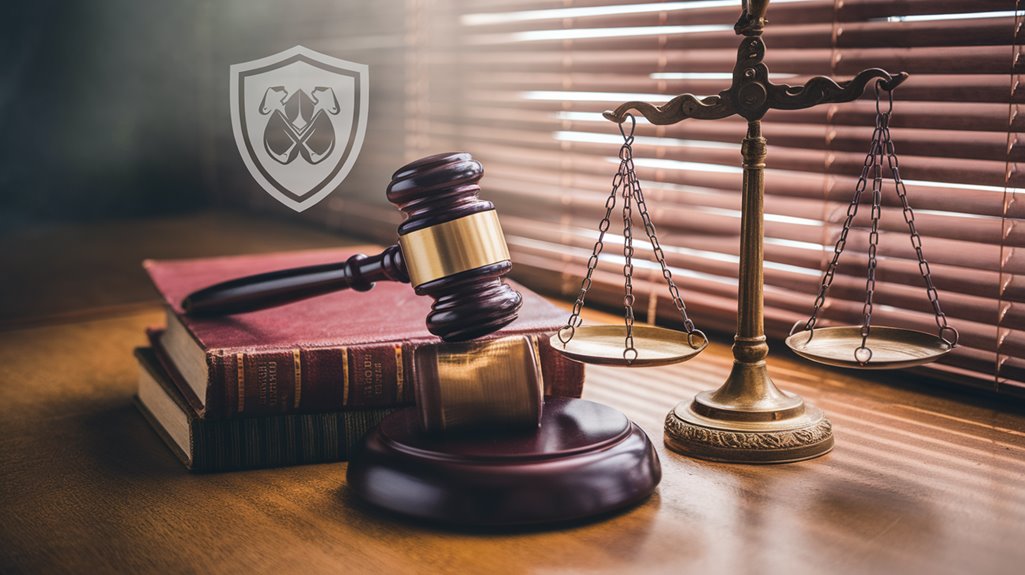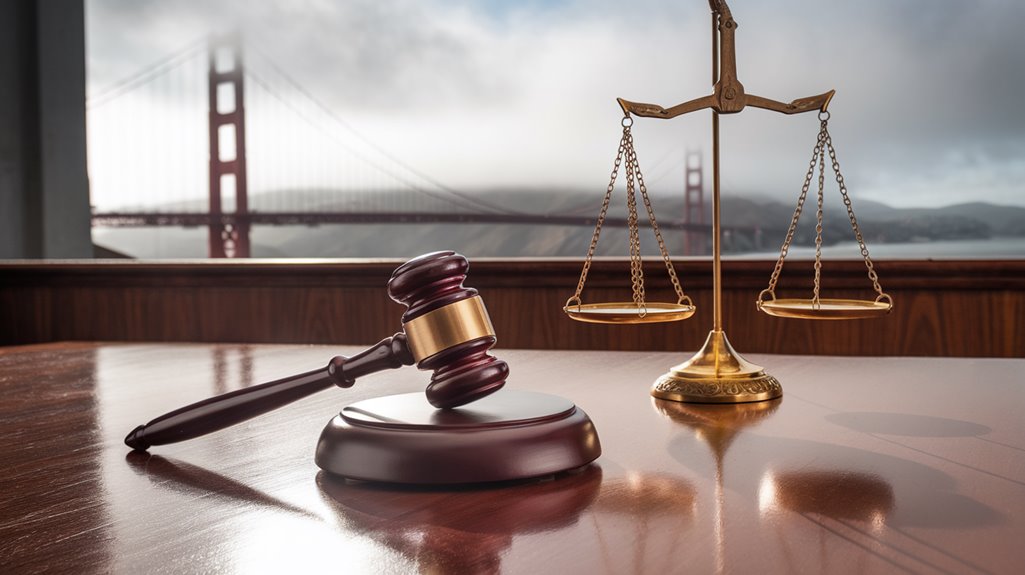Self-defense claims in the Bay Area require careful navigation of California law and attorney-client privilege. Three key pillars form the foundation: imminent danger, reasonable belief, and proportional response. The Castle Doctrine provides strong protection for home defense, while public spaces demand higher scrutiny. Attorneys must balance zealous representation with privilege management, especially when facing client accusations. Recent cases show successful outcomes hinge on proper documentation and strategic disclosure. Understanding these elements reveals critical insights for effective legal protection.
Key Takeaways
- Bay Area courts require clear evidence of imminent danger and proportional response in self-defense claims, following California's three-pillar system.
- Attorney-client privilege breaches are permitted when defending against client accusations, but require strict 28-day notice periods.
- Castle Doctrine provides strong protection for Bay Area homeowners, with 65% of cases resulting in acquittal or withdrawal.
- Attorneys must maintain detailed documentation and narrow disclosure strategies when handling privilege-sensitive self-defense cases.
- Self-defense claims require balancing context, evidence, and proper privilege management while adhering to local jurisdictional requirements.
The Three Pillars of California Self-Defense Law

California's self-defense laws rest on three fundamental principles that determine when the use of force is legally justified. First, a person must face imminent danger, meaning an immediate threat rather than a future possibility of harm. Second, defendants must demonstrate reasonable belief in the threat, which courts evaluate using both subjective experiences and objective standards. Under the Castle Doctrine, homeowners automatically receive presumption of reasonable fear when confronting intruders. Third, any defensive response must be proportional to the threat – non-lethal threats require non-lethal responses, while lethal force is only justified when facing risk of severe injury or death. Once the threat ends, continued force becomes illegal, and excessive responses can weaken or eliminate self-defense claims.
Navigating Stand Your Ground and Castle Doctrine Protections
California's self-defense laws establish distinct protections for both home and public spaces through Stand Your Ground case law and the Castle Doctrine statute. The Castle Doctrine gives residents broad rights to use force against home intruders, while Stand Your Ground principles extend self-defense rights to any lawful location without a duty to retreat. These protections require different standards of proof – home defense claims receive a presumption of reasonable fear under Penal Code §198.5, whereas public self-defense requires demonstrating an immediate, observable threat and proportional force response.
Home Defense Legal Rights
While homeowners have long held the right to defend their property, modern legal protections like the Castle Doctrine and Stand Your Ground principles provide specific guidelines for using force against intruders. In California, homeowner rights under Penal Code §198.5 allow the use of deadly force when facing reasonable fear of imminent harm from forcible intruders. However, intruder laws require that the response be proportional to the threat.
The Castle Doctrine applies specifically to residential properties and presumes fear is reasonable during forced entry situations. Homeowners don't have to retreat when threatened, but they must not have provoked the confrontation. Recent statistics show these protections are effective, with 65% of Castle Doctrine cases resulting in acquittal or withdrawal in 2023 California trials.
Public Space Defense Standards
Stand Your Ground laws greatly expand self-defense rights beyond traditional Castle Doctrine protections, establishing distinct standards for public spaces versus private property. In public venues, defenders must prove they had a reasonable belief of imminent danger, while also showing they had a legal right to be present during the confrontation.
Defense strategies often focus on documenting threat immediacy and demonstrating proportional response, as public perceptions of excessive force can profoundly impact jury decisions. Attorneys must carefully navigate these requirements while addressing prosecutors' challenges to the reasonableness of perceived threats. This becomes particularly complex in urban settings where evolving definitions of threat perception intersect with statutory requirements. Cases like Zimmerman/Martin highlight how public space defense claims face heightened scrutiny regarding the defender's conduct and threat assessment.
Attorney-Client Privilege Breaches in Self-Defense Cases

Courts have established clear standards for when attorneys can breach attorney-client privilege to defend themselves against client accusations or claims. Lawyers must typically wait for formal complaints before disclosing confidential information, with exceptions carefully limited to what's necessary for their defense. Warning signs that privilege may need to be breached in malpractice cases include clients making explicit allegations of negligence, disputing fees, or attempting to damage the attorney's credibility during legal proceedings.
Privilege Exceptions Legal Standards
As attorneys navigate self-defense situations, they must understand the specific legal standards that govern breaches of attorney-client privilege. Courts have established clear guidelines for when lawyers can disclose privileged communications to defend themselves. These privilege exceptions typically arise in malpractice suits, fee disputes, and misconduct allegations.
- Traditional scenarios allow disclosure when attorneys face formal charges or lawsuits from clients
- Recent case law has expanded exceptions to include pre-charge defense and prospective criminal investigations
- Jurisdictional differences exist, with some courts requiring formal charges while others accept preventive disclosure
Legal standards vary by jurisdiction, with states like California implementing strict relevance tests through Evidence Code 958, while federal circuits have adopted broader interpretations allowing preemptive disclosure during investigations. This landscape requires careful consideration of both state and federal requirements when asserting self-defense exceptions.
Malpractice Disclosure Warning Signs
Legal practitioners face mounting risks when invoking self-defense exceptions to attorney-client privilege in malpractice cases. Key warning signs include overbroad disclosures that exceed the scope needed for defense, and third-party exploitation of revealed client information. Such disclosures can inadvertently expose sensitive details that weaken the attorney’s position or violate ethical obligations. Additionally, opposing parties may attempt to introduce this information in unrelated litigation, such as slip and fall negligence claims, further complicating the legal landscape. To mitigate these risks, attorneys must carefully tailor their disclosures to avoid unnecessary breaches of confidentiality while still mounting an effective defense.
Attorneys must carefully weigh malpractice implications when considering self-defense disclosures. Courts consistently emphasize that such disclosures should be narrowly tailored to address only relevant communications. The *Meyerhoffer* case highlights how excessive disclosure can harm clients when adversaries use the information against them. Additionally, premature or voluntary disclosures may compromise client confidentiality and constitutional protections, particularly in cases with potential criminal implications. Practitioners should be especially vigilant when third parties attempt to leverage self-defense claims to access privileged communications beyond legitimate defense needs.
Criminal Charges and Self-Defense Outcome Analysis
Self-defense claims in criminal cases hinge on complex interactions between evidence, testimony, and legal standards. Courts analyze these cases by examining burden shifts between prosecution and defense, while evaluating the reasonableness of force used. Recent self defense precedents show that outcomes heavily depend on documented evidence and witness credibility.
- Prosecution must prove absence of self-defense in jurisdictions using preponderance standards, while defendants bear this burden in other states
- Physical evidence, expert testimony, and eyewitness accounts shape trial outcomes through objective third-party analysis
- Excessive force can convert valid self-defense claims into assault charges, especially when surveillance footage shows unnecessary escalation
The success of self-defense arguments relies heavily on demonstrating proportional response to genuine threats, supported by verifiable evidence and testimony.
Key Bay Area Legal Trends in Self-Defense Claims

Recent trends in Bay Area courts reveal distinct patterns in how self-defense claims are analyzed and processed. Courts increasingly emphasize objective standards when evaluating threat perception, moving away from common self-defense misconceptions about subjective fear being sufficient justification.
Legal precedent shows that while California maintains no duty to retreat, judges carefully examine whether force used matched the actual threat level. The courts particularly scrutinize cases involving domestic violence history or initial aggression. Prosecutors must disprove multiple elements of self-defense claims, but defendants face heightened burdens when force appears excessive relative to the threat.
Another notable trend involves the treatment of "Battered Spouse Syndrome" evidence, which courts now more readily accept when analyzing the context of defensive actions.
Managing Privilege Risks in Self-Defense Representation
While attorneys must zealously defend their clients in self-defense cases, they face complex challenges when protecting attorney-client privilege. Effective privilege management requires careful attention to disclosure strategies that balance defense needs with client confidentiality. California Evidence Code § 954 provides specific guidance for self-defense disclosures, but attorneys must still follow strict procedural safeguards.
- Courts require sworn declarations and 28-day client notice periods before allowing privilege waivers
- Disclosures must be narrowly tailored to specific communications directly related to defense claims
- Attorneys should pursue protective orders and non-disclosure agreements to prevent unauthorized information sharing
These measures help maintain ethical compliance while protecting both attorney and client interests. Proper documentation and timing of disclosures remain critical for managing privilege risks in self-defense representation.
Frequently Asked Questions
How Long After a Self-Defense Incident Can Criminal Charges Be Filed?
Criminal charge timelines for self-defense incidents vary by state and offense severity. Most serious crimes like murder have no time limit, while other felonies typically range from 3-10 years. Basic self-defense cases usually fall under standard criminal charge procedures with 3-5 year filing windows. However, these timelines can pause if the suspect leaves the state or faces other charges. Each jurisdiction follows different rules for when charges must be filed.
Can Security Camera Footage Alone Prove Reasonable Belief in Self-Defense Claims?
Like a mirror that only shows part of the room, security camera footage alone typically cannot fully prove reasonable belief in self-defense claims. While camera reliability can establish the physical sequence of events, footage interpretation cannot definitively show a person's state of mind or perceived threat level. Courts generally require additional evidence like witness testimony or expert analysis to demonstrate the defender's reasonable belief in imminent danger at the moment force was used.
Do Restraining Orders Affect Someone's Right to Claim Self-Defense?
Restraining order implications can affect self-defense rights, but don't completely eliminate them. A person with a restraining order against them must meet stricter standards to prove self-defense was necessary. They must show clear evidence of an immediate threat and that they tried to retreat first. Using force before attempting to leave the situation or responding with excessive force can invalidate their self-defense claim and result in additional legal consequences.
What Happens if Multiple Parties Involved Claim Self-Defense Against Each Other?
When multiple parties make mutual claims of self-defense against each other, the legal implications become complex. Courts must carefully examine physical evidence, witness statements, and individual actions to determine who initiated the conflict and whether each person's use of force was reasonable. Judges evaluate the timing of events, proportionality of force used, and opportunities to retreat. This often results in detailed analysis of each participant's role in the incident.
Can Prior Military Training Affect the Court's Assessment of Reasonable Force?
Prior military training can considerably impact how courts evaluate self-defense claims. While military expertise may demonstrate better judgment in threat assessment, courts often scrutinize whether the force used was truly reasonable for a civilian situation. The force evaluation considers if military training led to an overreaction or if the defendant should have known to use less aggressive civilian alternatives. Courts generally expect veterans to show greater restraint and situational awareness.
Conclusion
Understanding self-defense claims and privilege risks in the Bay Area requires careful navigation, much like steering a ship through foggy waters. Criminal defense attorneys must balance their duty to protect client confidentiality while building strong self-defense cases. As California laws continue to evolve, staying informed about local trends, privilege boundaries, and self-defense standards remains essential for successful legal representation and client protection.
